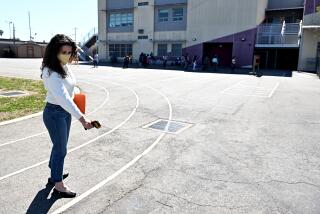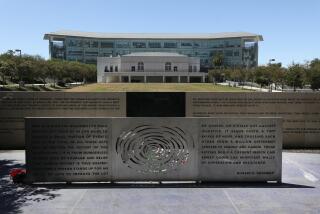Year-Round Challenge
- Share via
The Los Angeles school board will vote Monday on a plan to abandon the traditional school calendar in favor of year-round schooling. The school administrators believe that the change is necessary to alleviate bad overcrowding; the school district estimates that it needs 82,000 more classroom seats in the next five years. It cannot afford to build new schools and classrooms for that many students. Year-round schooling would make the best of a poor business.
Immigration has brought thousands of new students to Los Angeles. Many schools along the Wilshire corridor, in the eastern San Fernando Valley and in the South Gate area are severely overcrowded; 93 operate on a year-round calendar already.
The school system would have to build 10 new elementary schools, one junior high and a portion of a high school every year to keep up with growth, says Associate Supt. Jerry Halverson. That would cost $145 million to $170 million a year. Available bond money and tidelands oil revenue fall far short of that need.
The school system should not switch immediately to year-round schools, because too many schools are too hot in the summer. The district has finished air-conditioning only about 60% of the schools already on a year-round basis. That work should take two more years. It will cost about $300 million to air-condition the schools that will need it if the system goes year round. Air conditioning is a necessity for year-round schooling.
In the meantime, the board will consider alleviating some of its most immediate overcrowding through two steps: slightly increasing class sizes and changing the integration ratio in some schools to allow more minority children to attend them. Changing the integration ratio slightly may not harm education, although the courts may frown on it, but increasing class sizes would. It should be resisted if at all possible.
Parents who oppose the year-round plan contend that the system has 63,000 vacant seats now. Halverson says that there are 46,000. Some are in schools in areas of the district like the harbor or the west San Fernando Valley that are too far away to serve students from overcrowded areas. Some empty seats are in programs whose enrollments must be kept low because of special education or other course requirements. And 16,000 of the vacant seats are in segregated schools; the district can offer the spaces to students, but the courts would take a dim view of any deliberate order to attend those schools.
There will be problems in switching to a year-round, multitrack calendar. As now proposed, a school probably would have its students divided into five groups, with four on the school grounds at any one time for nine-week terms. Some families would have children on different schedules. Some would have long winter, not summer, vacations--although everyone would have the same three-week summer break and two-week winter break. The district should listen carefully to worried parents and students to try to reduce problems.
The year-round schedule should be phased in over several years, starting with the schools most overcrowded and the schools to which great numbers of students may have to be transported.
The switch to year-round schooling, disruptive as it may be at first, is a challenge to the entire city to make education as solid as possible for all of its students.
More to Read
Sign up for Essential California
The most important California stories and recommendations in your inbox every morning.
You may occasionally receive promotional content from the Los Angeles Times.













